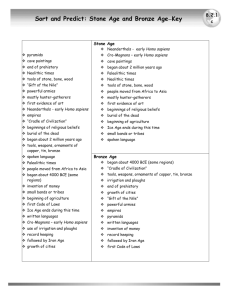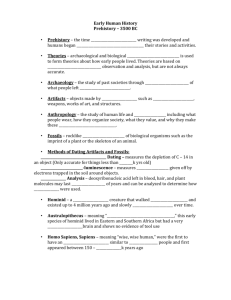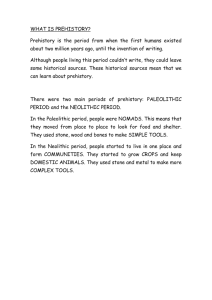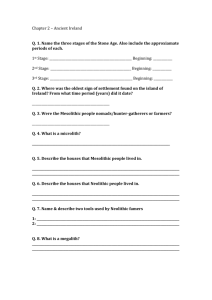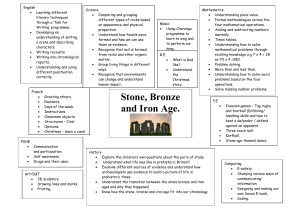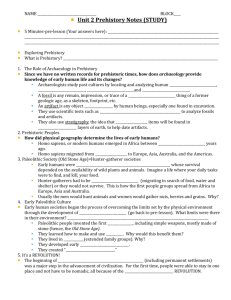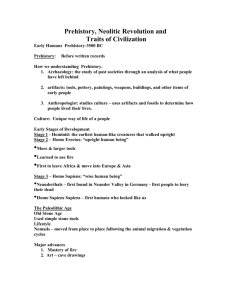File
advertisement
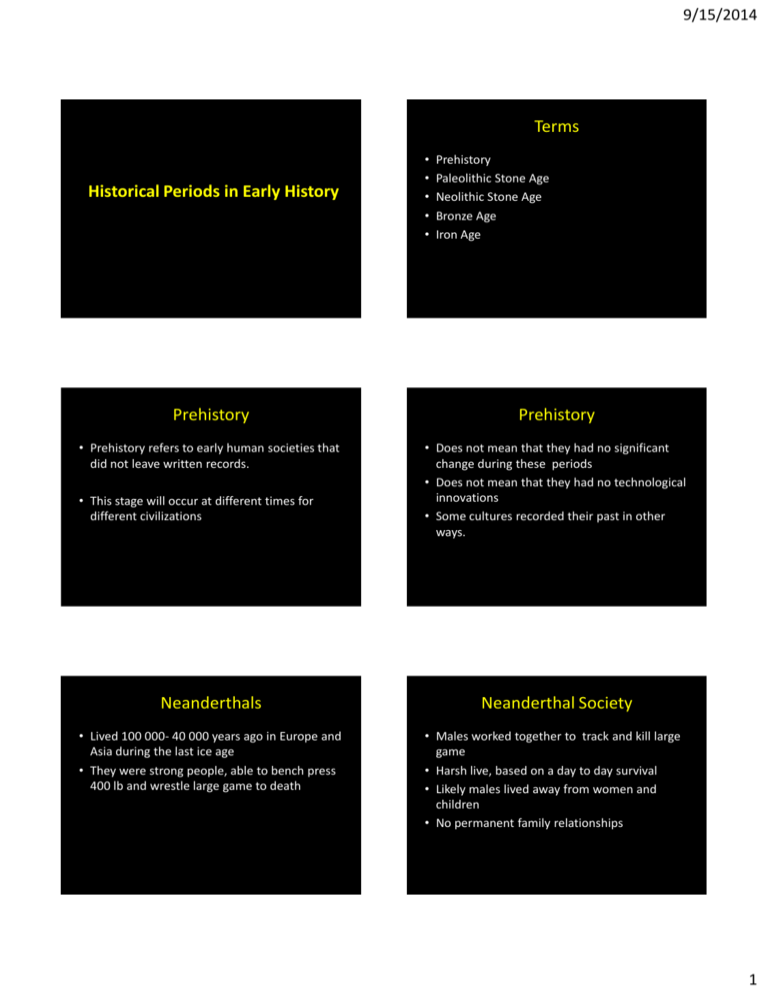
9/15/2014 Terms Historical Periods in Early History • • • • • Prehistory Paleolithic Stone Age Neolithic Stone Age Bronze Age Iron Age Prehistory Prehistory • Prehistory refers to early human societies that did not leave written records. • Does not mean that they had no significant change during these periods • Does not mean that they had no technological innovations • Some cultures recorded their past in other ways. • This stage will occur at different times for different civilizations Neanderthals • Lived 100 000- 40 000 years ago in Europe and Asia during the last ice age • They were strong people, able to bench press 400 lb and wrestle large game to death Neanderthal Society • Males worked together to track and kill large game • Harsh live, based on a day to day survival • Likely males lived away from women and children • No permanent family relationships 1 9/15/2014 Neanderthal Society • No formal leadership • No rules or laws that people were to follow • No primitive religion known and if there was it had few rituals • No moral code to guide life • While they wore clothes, they were just wraps thrown over themselves Neanderthal Women • Females and children spent more time close to the cave fire • Preparing plant foods they gathered • Scraps brought to them by males • All gathering done by women and children were critical to survival What happened to Neanderthals • There is uncertainty as to why they died off • Did the humans from africa, Homo sapiens sapiens invade and kill them off? • Homo sapiens had better weapons and tools? • Did they have superior intelligence? • More than likely died off by killing, disease and displacement • Assimilation? Homo sapiens sapiens hybrid Neanderthal Men • Scavenged for food as much as they hunted • Horses head excavated in many sites Skeletons of Neanderthals • Skeletal remains show a difficult life • Most children died in childbirth or the first dew years of life • 80% of Neanderthals died before age 40 What has been discovered Quite recently • There is some Neanderthal genes in the human DNA in a significant amount – First suggested offspring would not be viable as they had a 12 month pregnancy, now not so sure • There is now art work present to suggest they did have culture • Their tools have been discovered to be more complex then first thought. 2 9/15/2014 Homo sapien sapien: The Great Leap Forward • 35 000 years ago something remarkable happened, known as the “Great Leap Forward” • Innovation and creativity • Tools made of thin stone blades • Spears • Needles to make clothes • Items for preparing food • Axes for cutting wood Paleolithic Age- “Old Stone Age” • 50 000- 10 000 Years Ago • -social hierarchies, alliances, marriage, customs, religion, refined artistic beauty • Trade • Small family groups • Leadership, social classes • Better hunting, lethal weapons • Ability to sew clothes • Adapt to changes in environment More Innovation • • • • • • • Barbed harpoons Darts Throwing spears Bows and arrows Watercraft Trade Culture ?? Paleolithic Society- Women • Gathering of food was done by women and children accounting for 60-70 of the diet • Made clothing • Nurtured the young • The wisdom and story tellers were elder women Paleolithic Art • Cave paintings • Sculpture 3 9/15/2014 Neolithic Age-The New Stone Age • • • • • Refers to around 9000 BC Ground and polished tools Abandon nomadic life to begin farming Planting Crops, Domesticating animals Humans can now control their food source Neolithic Food • Animals domesticated- cattle, sheep, goats, pigs • Supplied meat, leather, and milk (Cheese and butter) • Grains were grown. Two drinks enjoyed were mead and beer • Late period, began metallurgy- copper made knives, cups, buckets, and pots Neolithic Society • • • • Permanent towns Specialized in crafts Hierarchical class system Agriculture allowed them to develop art, music and sports, • Religion 7 Characteristics of a Society • • • • • • • Centralized Government Agricultural Intensification Specialized Occupations Class Structure Merchants and Trades Development of Science and Writing State Religion 4 9/15/2014 Bronze Age Bronze Age • Bronze Age would be followed by the Iron Age but not always • More broadly, the Bronze Age of any culture is the period during which the most advanced metalworking (at least in systematic and widespread use) in that culture uses bronze. • This could either be based on the local smelting of copper and tin from ores, or trading for bronze from production areas elsewhere. • Copper/tin ores are rare, as reflected in the fact that there were no tin bronzes in western Asia before 3000 BC. Many, though not all, Bronze Age cultures flourished in prehistory. • Some cultures developed extensive written records during their Bronze Ages. Iron Age • The Iron Age typically follows the Bronze age (But not always) • Stage in the development of any people in which tools and weapons whose main ingredient was iron were prominent. • The adoption of this material often coincided with other changes in society, including differing agricultural practices, religious beliefs and artistic styles. 5
